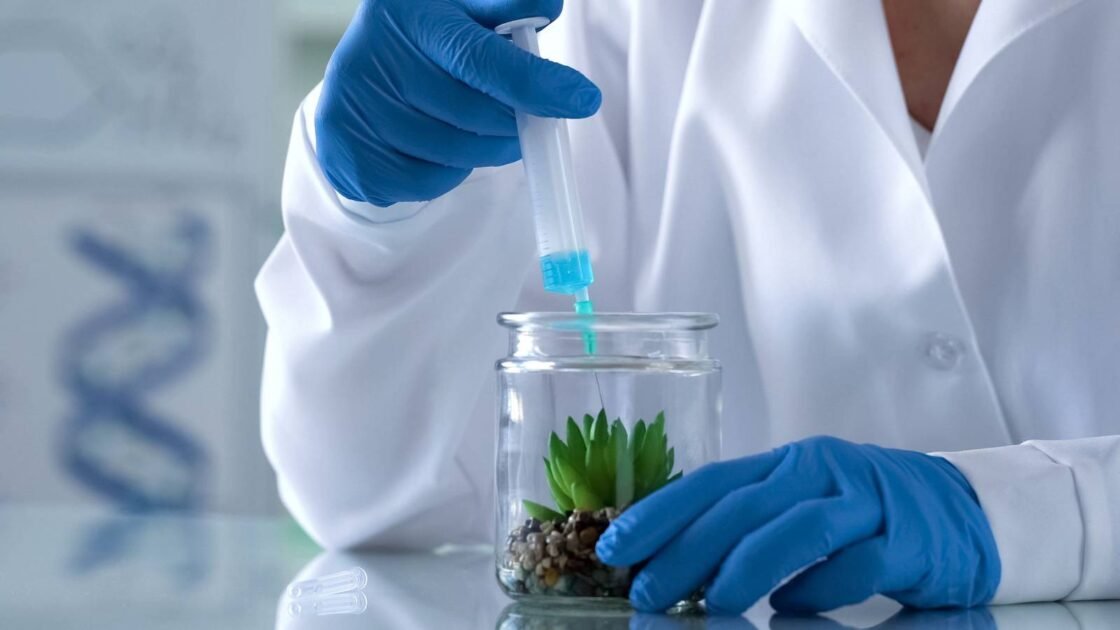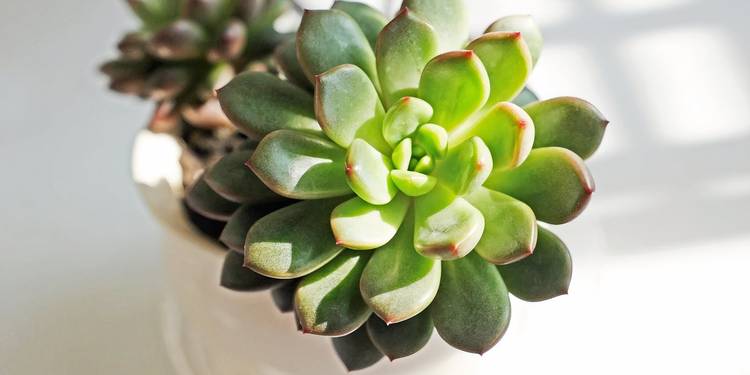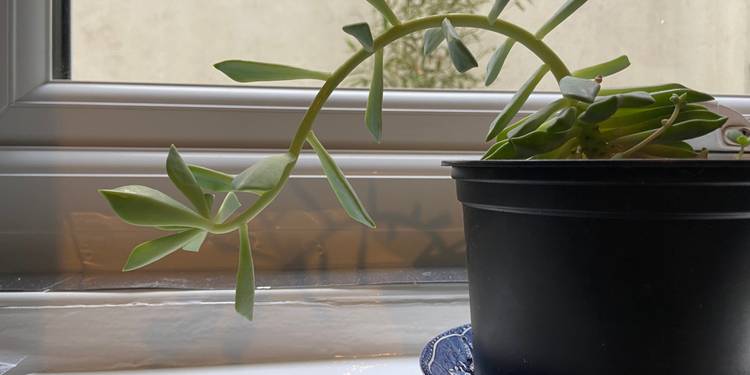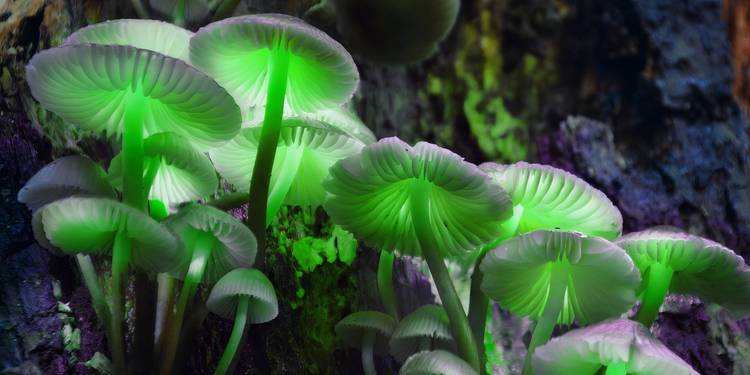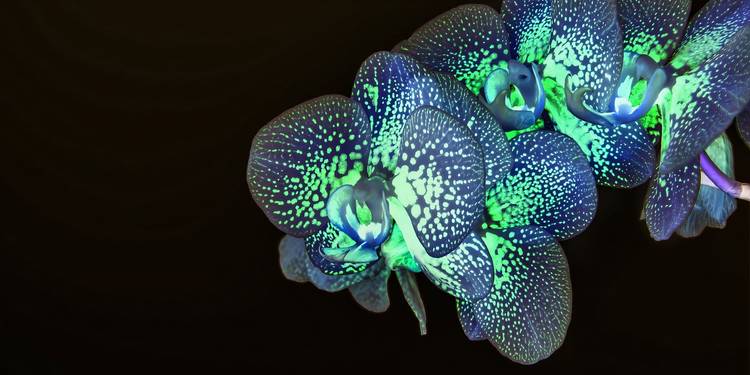For centuries, humans have been fascinated by the idea of nature producing its own light. Fireflies, bioluminescent fungi, and deep-sea creatures demonstrate how organic life can sparkle in darkness. Now, science has pushed this concept further, creating glow in the dark plants that shine without batteries or wires.
Unlike genetically modified plants or genetically engineered crops that alter DNA, this breakthrough in China uses phosphorescent particles to achieve illumination without changing the plant’s natural structure. Say hello to the future of plants!
The Science Behind Glowing Plants
Micron-sized particles absorb sunlight and re-emit it as plant light

Glow in the dark paint jar and brush on a blue background
Understanding why these plants shine requires a look at the underlying technology. According to the news outlet Channel3000, researchers have developed a method that allows ordinary succulents to radiate light in multiple hues, producing what many are calling the first generation of truly colorful plants.
- Unlike traditional lamps, the effect is achieved by injecting strontium aluminate — a phosphorescent material commonly used in glowing toys and stickers.
- It works by absorbing light and then releasing it slowly, a process known as phosphorescence, rather than relying on continuous chemical reactions like bioluminescence.
- This creates a sustainable light source when charged by sunlight.
To grasp the significance of this process, consider key scientific highlights:
- Research Inspiration: Lead researcher Shuting Liu told CNN that the team was driven by, “inorganic afterglow materials that can be charged by light and then release it slowly,” and by earlier glowing plant concepts, including ideas of plant streetlights.
- Phosphor Absorption and Emission: These materials store energy from natural light and release it slowly, allowing the plant to glow in the dark.
- Structural Suitability: Plants such as Echeveria “Mebina” were chosen because its leaves have thin and uniform channels that allow micron-sized phosphor particles to spread evenly, as noted by Smithsonian Magazine.
- Durability: Liu also reported that the treated plants maintained their ability to glow for 25 days after treatment, with even wilted leaves continuing to emit light under UV exposure. This suggests a durability that could make the plants more reliable as living light sources.
- Innovation In China: The glow of these colorful plants lasts up to two hours after charging, but extending that time is a primary research goal if these are to compete with traditional lighting systems.
- Contrast To GM Approaches: Unlike genetically modified plants, this approach does not alter DNA but instead complements existing biological structures.
Why Succulents Were Chosen
Thick, uniform leaves distribute glow evenly and keep the plant healthy

A potted echeveria plant next to a window
Scientists could have tested many species, but certain plants performed better than others. Unlike bok choy or golden pothos, the succulent species possess relatively wide gaps between their leaf cells. This structural difference allows micron-sized phosphorescent particles to move more freely through plant tissue, producing an even and sustained glow, according to the study published in Live Science.
They also proved ideal for demonstrating one of the most striking breakthroughs: the ability to glow in blue, green, red, and blue-violet, making them the first truly multicolored glowing plants.
Several specific factors make them an ideal candidate:
- Leaf Density: Thick but uniform leaves spread particles smoothly, producing a more even glow in the dark effect.
- Durability: Their natural water storage helps maintain tissue health, even after injection, which is vital for research in China.
- Visual Diversity: Already admired as colorful plants, their glowing hues add novelty to an already ornamental plant group.
- Low Maintenance: Compared to other species, these are easier to care for, making them attractive alternatives to genetically modified plants that require specialized cultivation.
- Potential Applications: Their stable glow provides a test model that could later expand into larger genetically engineered crops.
Environmental Impacts and Concerns
Phosphor residue may require safe disposal when plants eventually die

leggy and dropping plant
Introducing a glowing plant raises ecological questions. While no genetic structure is altered, the introduction of new materials could still affect ecosystems and long-term growth. At the same time, the technology is inexpensive — approximately $1.40 per plant in material costs, as noted by SciTechDaily — raising questions about affordability versus environmental responsibility when scaled to mass production.
In weighing the environmental implications, consider some key dimensions:
- Duration of Light: Each plant can glow in the dark for up to two hours before recharging. While this offers an eco-friendly alternative to short-use lighting, its limited duration raises questions about whether it can realistically reduce dependence on traditional energy sources.
- Impact On Plant Health: Research on succulents shows no immediate damage from treatment, and the plants continue to function normally. However, long-term studies are still needed to understand how persistent materials might affect surrounding ecosystems or future plant generations.
- Laboratory Setting: Current experiments in China are conducted in controlled laboratory environments, which prevents unintended interactions with natural ecosystems. While this reduces immediate ecological risks, it also means the real-world environmental impacts remain largely untested.
- Material Safety: Although marketed as harmless, phosphor particles differ from natural pigments found in colorful plants. Their persistence in soil or water could create unforeseen ecological effects, making disposal and long-term monitoring important concerns.
- Comparison With GM Crops: Unlike genetically modified plants, these experiments avoid DNA alteration but still introduce external substances not found in genetically engineered crops.
- Potential Waste Issue: When plants die, the safe disposal of the phosphor material becomes an important responsibility. If left unmanaged, these remnants could linger in the environment, raising long-term sustainability concerns.
Potential Applications in Everyday Life
Glowing plants could illuminate homes, pathways, and parks without electricity
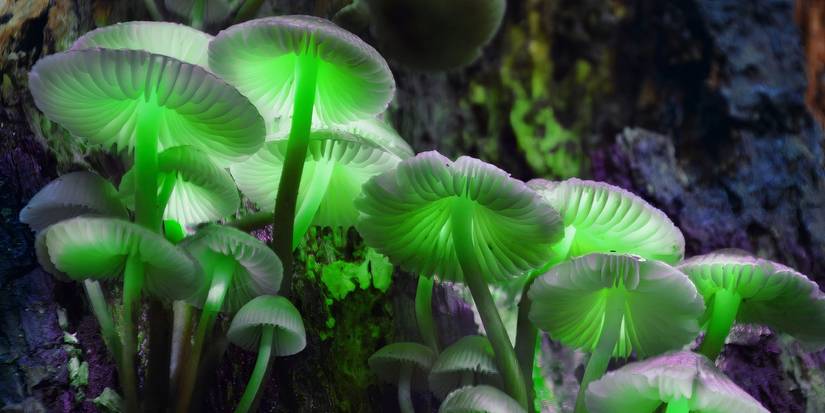
Foxfire mushrooms glowing in the dark
The dream of glowing greenery goes far beyond the laboratory. Home design, urban planning, and energy efficiency all stand to benefit from such advances. Current preparation methods are also surprisingly efficient: researchers can treat each leaf in about 10 minutes, making commercial possibilities far more practical than early experimental plant technologies.
Among the most intriguing uses being discussed are:
- Home Decor: People could enjoy glow in the dark plants on tables or shelves, replacing small lamps.
- Urban Greenery: Parks filled with glowing succulents could transform night walks into radiant experiences in China and beyond.
- Sustainable Light: As colorful plants, these can reduce electricity use by serving as natural night lights.
- Agricultural Testing: Unlike genetically modified plants, which often face resistance, glowing varieties could win consumer curiosity more quickly.
- Public Lighting: The dream of genetically engineered crops that double as lighting systems may be closer than previously thought.
- Safety Pathways: Pathways lit by glowing flora would reduce the need for powered ground lighting in public spaces.
The Future of Plant-Based Lighting
Researchers aim to extend glow time and expand it to larger species
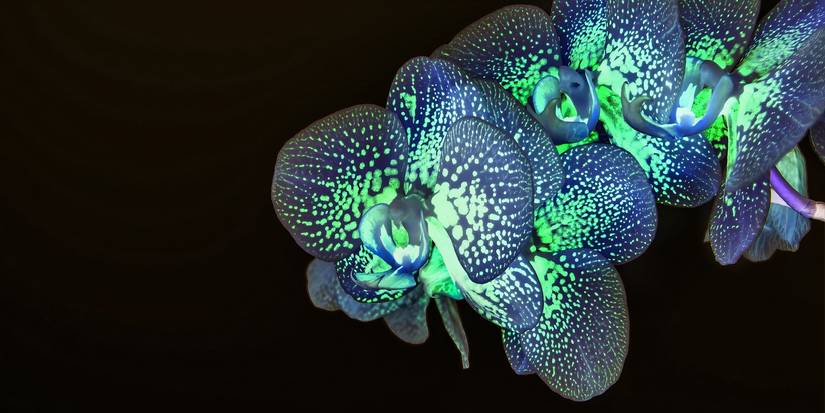
Orchids glowing with a black background.
Looking ahead, glowing plants represent a merging of science, sustainability, and imagination. Scientists are now exploring ways to extend glow duration and apply the technology to larger plant varieties.
Key elements of future development include:
|
Element |
Description |
|---|---|
|
Longer-Lasting Luminescence |
Increasing the hours a plant can glow in the dark will make it more practical for consumers. |
|
Wider Plant Testing |
While succulents succeeded first, researchers in China are experimenting with other species for broader use. |
|
Commercial Market |
Demand for colorful plants that double as lights will encourage partnerships with designers and retailers. |
|
Comparative Innovation |
Unlike genetically modified plants, these approaches emphasize physical infusion rather than molecular change. |
|
Energy-Efficient Goals |
According to Live Science, researchers envision genetically engineered crops evolving into low-carbon lighting solutions, potentially replacing streetlights with greenery. |
|
Cultural Adoption |
Glowing plants may inspire art, events, and spiritual practices worldwide. |
|
Urban Sustainability |
Entire districts could rely on glowing flora to supplement or replace certain artificial lighting systems. |
A Luminous Glimpse into Nature’s Future
From fascination to practical reality, glowing flora reveal a remarkable step in blending science with beauty. The ability to glow in the dark no longer belongs solely to insects or deep-sea creatures. Now, ordinary succulents transformed by researchers in China stand as proof that light can spring from leaves.
Such innovations produce colorful plants with functions far beyond decoration, demonstrating alternatives to genetically modified plants and raising new questions about how genetically engineered crops may evolve. While challenges remain, the luminous beauty of the creations captures people’s imagination and hints at greener, brighter futures.












































































































